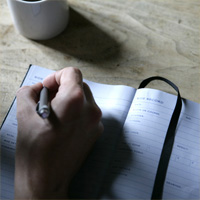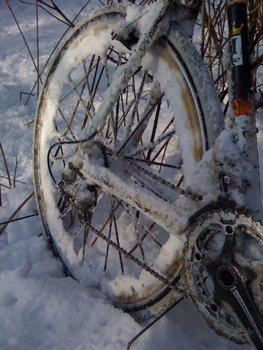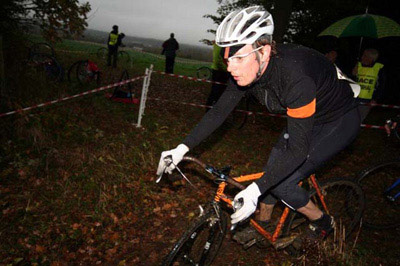
..........................................................................................................................................................................................................
rapha's luke scheybeler

Ah... yes I did say that... well, I'm not sure which half of which 1980s synth-pop duo I'd compare us, maybe Yazoo... as long as I'm not Alison Moyet.
In many ways it's a division of labour thing, we have to look after different areas of the business. Simon has a background in accountancy and brand strategy and focuses on financial management, the PR and the day-to-day business operations...he tends to be a lot more 'outward facing'. Whereas I focus on running the creative side and ensure that it meets our commercial goals. So that involves shaping the range and designing the products, oversight of the brand, designing the brochures, working with Ben Ingham [Rapha's photographer] on photography and designing and overseeing the website. It's a pretty wide remit so I get less time to do press.
There are things that we both do - guiding the business strategy, marketing and sales, mucking in with stocktakes, supporting the team, running the company meetings, etc. I think that people in Rapha see it very much as a partnership.
Sure, that's what makes the thing work - you've got to focus on your strengths.
Well my background is in graphics, interactive design and brand strategy. I worked at various London-based design agencies, on a lot of early web stuff. But without wanting to sound pompous I consider myself an entrepreneur. My career followed the path of a designer, but I think that when you work in a company rather than an agency you feel the commercial imperative much more keenly and the day-to-day decisions you make have direct and measurable impacts. So, I suppose what I bring is being able to link creative ideas to good business decisions.
At Rapha the creative is very closely linked into the day-to-day sales and marketing efforts. Ideas for offers or deals are just as likely to come from the creative team as they are from the sales or marketing people. It's a very tight group and it works very well.
We have a big advantage selling our stuff direct via the website - it gives us the opportunity to speak directly to our customers and to get really fast feedback on products. Although we're at the premium end of the market, we're still very accessible.
I've been dabbling in the London Cyclocross League this year which has been a lesson in ... well, a lot of things - falling off and bike cleaning mostly. I raced crits at Eastway a couple of times, but was always taken to bits and ended up in the clubroom trying to caffeinate myself back to life with sugary tea. The new course at Hogg Hill is a great though - I take my kids there on a saturday morning to the Lea Valley club and they go mountain biking on the off-road course.
I have a love-hate relationship with riding in town. Sometimes it can be transcendental and other times it can be grindingly irritating and dangerous. I guess it depends on my mood. I'm never happier than riding my favourite hundred mile loop in Corsica. I love it, it's a magical place. You get a very clear sense of height and distance riding on an island - I'm sure you can relate to this.

I think people should be themselves actually. I think that there is a lot of and creativity out there, I'd prefer it if someone has their own sense of style and mixes things up a bit, rather than looking like a page from our (or anyone else's) brochure.
We did a semi-tongue-in-cheek ad in Bicycling magazine last year, called the "Rapha Rules", which had these edicts about how and what to wear on the bike. Some of it was things we hate, like... "never have a gap between your armwarmer and your jersey sleeve".. stuff like that. But the final rule was "Be yourself"... I think that some people never made it to that last rule... we got some interesting responses.
I think is important for cycling to be seen as stylish and cool. The geeky, neon commuter-wear that dominates the road is just horrible, it doesn't need to be like that. If that's the image that cycling portrays then it's going to discourage a lot of people from riding bikes - we've got to use this passion and cool to lure kids into this sport.
That I think is the great thing that the whole fixed gear thing has brought in the last five or so years - it's brought a whole new generation of people to cycling. A lot of those people who up until now only rode track bikes are now getting road bikes... it all helps.
Well when we started Rapha neither of us had any clothing experience whatsoever, we learned it on the job and it is a steep learning curve, but with the right technical people and production contacts you can make it work. I'm pretty convinced that if you're a good designer in one medium then you can transfer your skills to another. It just takes a bit of time and hard work.

Without wanting to get too theoretical, I think the point about design, or any other creative endeavour for that matter, is that you need to be operating within a set of rules. And that ruleset is constructed by the marketplace that you're in, the brand you've created and the medium that you're communicating with - those rules help to guide your decisions. If you can do anything then you'll end up getting nowhere, somehow you've got to narrow things down.
The Rapha brand, the physical position that the body is in on the bike, the historic stories of the sport... all these things are the ruleset that we've created or follow (or break) when we consider potential Rapha products.
But you can't break it down into a formula. You've got to have a rational starting place, but you also need a spark of inspiration, something random or stupid or intentionally counter trend... you've got to take risks.
One of our jerseys for '09 has graphics based on the Vaux's Swifts which roost in a school chimney in Portland. I chanced upon this when I was out there last. Thousands of these birds swirl down into this thing, it's incredible, I kept on expecting David Attenborough to start narrating. It made a bit of an impression on me and so I designed a jersey using this flock of swifts... black-on-black of course. Random chance like that is very important for generating ideas.
Well, some drop off at the idea stage, some are discounted for commercial, feasibility or brand reasons and some don't make it through production. But we have to very careful not to try to take on too much. Generating the ideas is not a problem, having enough time and resources to produce them is.
There are a few things that we've designed, had prototypes made, just about finished and then have been killed for a production mistake or a factory problem...

Not as long as it should be!
Well it's important that we keep surprising people, but conversely it's also very important that everything we do rings true to the brand. That's the line you have to walk, it's got to be credibly 'Rapha' and yet move things forward.
We're still pretty lean so we can turn projects round fast if we need to, the product development cycle is pretty hard to shortcut though... it's got it's own cadence!
Yes! No! What's the right answer here? Seriously, I think it's important to be consensual, this is a business after all. So, I don't think that I'd try to push something through that was commercial suicide... but I stand up for quality and a coherent design approach.
Well, I design the Rapha Condor team jerseys every season and it's an exercise in making the least bad compromise, I sympathise with the kit designers of the world. You have to satisfy lots of different requirements simultaneously - from hierarchy of logos (it's easy to annoy any key sponsors) to the placement for certain shots to where the numbers are pinned... etc, etc, etc..
It's funny though, I'm beginning to really like utterly thoughtless graphical applications - they sometimes have a certain charm. The Barloworld team bike from last year was great. It was just a standard celeste-green Bianchi frame with logos in ugly red blocks just plastered onto it... it was like they'd been dropped straight into Photoshop from the web or something. It was hilarious - but the overall effect was great. It had a hardcore 'rally car' kind of feel to it - that's so much cooler than an airbrushed eagle or a fighter jet... (Italian bike brand... you know who you are!)
The thing is is that most team kit is literally just straight from the sponsor's corporate identity manual. And if your sponsor is a aggregates company or a hearing aid manufacturer or a boiler engineering firm then their visual identity is unlikely to be that inspiring (Fassa Bortolo was the exception that proved this rule).
The problem is ultimately that the teams don't really have a life beyond the sponsor. If they were entities in their own right with their own name and visual language then there would be so much more opportunity for creating enduring team brands.
Think about the amazing use of colour in football, it is a tribal thing... think about Liverpool, Newcastle, West Ham... even Italy or Brazil... those colours and kits are etched on the minds of fans across the world.
Football fans grow up with the colour and the team name and these incredible brands (and businesses) have grown up as a result - the sponsors are happy to associate their names with these amazing brands. My son knew he was an Arsenal fan before he could ride a bike - simply through living where we live. If cycling could emulate that and try to avoid the constant churn of name and kit then it'd do a lot for the sport.
Some cycling jerseys have capturing exactly the same passion, but the teams are always ephemeral... Bianchi is the only exception really. That colour and the legend of Coppi has endured, and it's done so much for the Bianchi brand. Slipstream looked like they were going down that road for a while.
Brian, surely, as a typographer, you know that one follows the other!
Well, I actually think that form should emphasise function, it's not just enough to be brutally utilitarian, for people to fall in love with objects they must A. actually work, B. be simple and straightforward to use or understand, and C. authentically encapsulate the cultural and stylistic world that the object inhabits. It's not enough for a sports car to go fast, it's got to look fast. Some of that comes from it's function (aerodynamics for example), but some of it comes from styling.. giving it aggressively flared 'haunches' like a powerful animal... it doesn't need to look like that, it's just the whole object makes more sense if it does. But the car has also got to be authentic in a cutural sense. That's why for Alfa Romeo, the idea of 'unreliability', weirdly, is actually a positive - it's so authentically Italian.
Authenticity has to be articulated somehow. Whether it's in the form of an Italian road bike, a British Saville Row suit or an American handmade guitar. Authenticity can come from tradition or heritage, or it can come via demonstrating a commitment to and an understanding of the world that the object lives in.
New brands have to work that extra bit harder to show that they're authentic. Fortunately, at Rapha, our passion for the sport is genuine, the Rapha Condor team really is out there racing on the continent and the stories that we tell are ones that we love. I think the challenge for a lot of brands, particularly within cycling, is that they get stuck in a one-dimensional obsession with 'performance'... and once everyone is using the same technologies (and the rate of technological change is pretty slow) then there is nothing to set the brands apart.
The heated discussions arise form how to do stuff, not what to do. I think we're pretty aligned in terms of what is right for Rapha, the difficulty is delivering stuff with limited resources and limited time.
Never look back.
It's hard because I'm very proud of the whole thing, it's a brand we've built more than anything, but in terms of something specific, and it's not a product, I'm very proud of the Smithfield Nocturne.
In our first year we were talking about a number of different events that we could do in London including hill climbs, roller races, all sorts of stuff. I felt very strongly that if we could find a decent venue for a continental-style crit in central London, with bars and decent transport links then we could create something really special. For the next few weeks I was constantly looking for potential circuits wherever I rode through London, Covent Garden? Wapping? Regents Park? Eventually, I realised that Smithfield Market [an ancient livestock market in central London] had all the elements - as well as a being a beautiful and historic place. There were some potential problems - it was governed by three boroughs which made things slightly bureaucratic and we were also alerted to the fact that racing on roads covered with a very thin coating of animal grease was potentially dangerous! But with Face Partnership we did the deals (and called in extra road sweepers to wash off the pig fat) and put on an amazing event. To be honest it's the only time I've really had to pinch myself - it felt like an out of body experience, an amazing day - from Warrick Spence's audacious solo break, to the torrential rain shower, to the huge crowds. I couldn't really have hoped for better.

In terms of products, I'm really privileged to have been able to work with Paul Smith on a Jersey a couple of years ago, and working with Timothy Everest [the British Tailor] on a suit has been an very interesting and rewarding experience - the bespoke process is just wonderful. So those things were great.
But most of all I love the classic jersey. It was a classic case of removing elements until the thing just worked... I was left with a black jersey with a single stripe on the left arm... we were searching for something simple but this was the eureka moment.
It certainly has its moments.
I'd be playing banjo in a old-time country band in the Appalachian Mountains.

posted on thursday 12 march 2009
..........................................................................................................................................................................................................